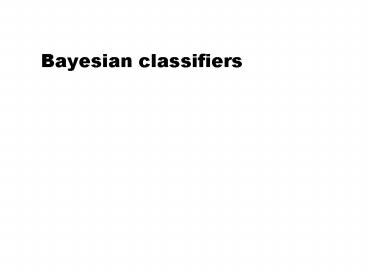Bayesian classifiers - PowerPoint PPT Presentation
1 / 13
Title:
Bayesian classifiers
Description:
Incremental: Each training example can incrementally increase/decrease the ... that combine Bayesian reasoning with causal relationships between attributes ... – PowerPoint PPT presentation
Number of Views:52
Avg rating:3.0/5.0
Title: Bayesian classifiers
1
Bayesian classifiers
2
Bayesian Classification Why?
- Probabilistic learning Calculate explicit
probabilities for hypothesis, among the most
practical approaches to certain types of learning
problems - Incremental Each training example can
incrementally increase/decrease the probability
that a hypothesis is correct. Prior knowledge
can be combined with observed data. - Probabilistic prediction Predict multiple
hypotheses, weighted by their probabilities - Standard Even when Bayesian methods are
computationally intractable, they can provide a
standard of optimal decision making against which
other methods can be measured
3
Bayesian Theorem
- Given training data D, posteriori probability of
a hypothesis h, P(hD) follows the Bayes theorem - MAP (maximum posteriori) hypothesis
- Practical difficulty require initial knowledge
of many probabilities, significant computational
cost
4
Naïve Bayes Classifier (I)
- A simplified assumption attributes are
conditionally independent - Greatly reduces the computation cost, only count
the class distribution.
5
Naïve Bayesian Classification
- If i-th attribute is categoricalP(diC) is
estimated as the relative freq of samples having
value di as i-th attribute in class C - If i-th attribute is continuousP(diC) is
estimated thru a Gaussian density function - Computationally easy in both cases
6
Play-tennis example estimating P(xiC)
7
Naive Bayesian Classifier (II)
- Given a training set, we can compute the
probabilities
8
Play-tennis example classifying X
- An unseen sample X ltrain, hot, high, falsegt
- P(Xp)P(p) P(rainp)P(hotp)P(highp)P(fals
ep)P(p) 3/92/93/96/99/14 0.010582 - P(Xn)P(n) P(rainn)P(hotn)P(highn)P(fals
en)P(n) 2/52/54/52/55/14 0.018286 - Sample X is classified in class n (dont play)
9
The independence hypothesis
- makes computation possible
- yields optimal classifiers when satisfied
- but is seldom satisfied in practice, as
attributes (variables) are often correlated. - Attempts to overcome this limitation
- Bayesian networks, that combine Bayesian
reasoning with causal relationships between
attributes
10
Bayesian Belief Networks (I)
Age
FamilyH
(FH, A)
(FH, A)
(FH, A)
(FH, A)
M
0.7
0.8
0.5
0.1
Diabetes
Mass
M
0.3
0.2
0.5
0.9
The conditional probability table for the
variable Mass
Insulin
Glucose
Bayesian Belief Networks
11
Applying Bayesian nets
- When all but one variable known
- P(DA,F,M,G,I)
12
Bayesian belief network
- Find joint probability over set of variables
making use of conditional independence whenever
known
a
d
ad ad ad ad
b
b
0.1 0.2 0.3 0.4
Variable e independent of d given b
b
0.3 0.2 0.1 0.5
e
C
13
Bayesian Belief Networks (II)
- Bayesian belief network allows a subset of the
variables conditionally independent - A graphical model of causal relationships
- Several cases of learning Bayesian belief
networks - Given both network structure and all the
variables easy - Given network structure but only some variables
use gradient descent / EM algorithms - When the network structure is not known in
advance - Learning structure of network harder
14
The k-Nearest Neighbor Algorithm
- All instances correspond to points in the n-D
space. - The nearest neighbor are defined in terms of
Euclidean distance. - The target function could be discrete- or real-
valued. - For discrete-valued, the k-NN returns the most
common value among the k training examples
nearest to xq. - Vonoroi diagram the decision surface induced by
1-NN for a typical set of training examples.
.
_
_
_
.
_
.
.
.
_
xq
.
_
15
Discussion on the k-NN Algorithm
- The k-NN algorithm for continuous-valued target
functions - Calculate the mean values of the k nearest
neighbors - Distance-weighted nearest neighbor algorithm
- Weight the contribution of each of the k
neighbors according to their distance to the
query point xq - giving greater weight to closer neighbors
- Similarly, for real-valued target functions
- Robust to noisy data by averaging k-nearest
neighbors - Curse of dimensionality distance between
neighbors could be dominated by irrelevant
attributes. - To overcome it, axes stretch or elimination of
the least relevant attributes.































